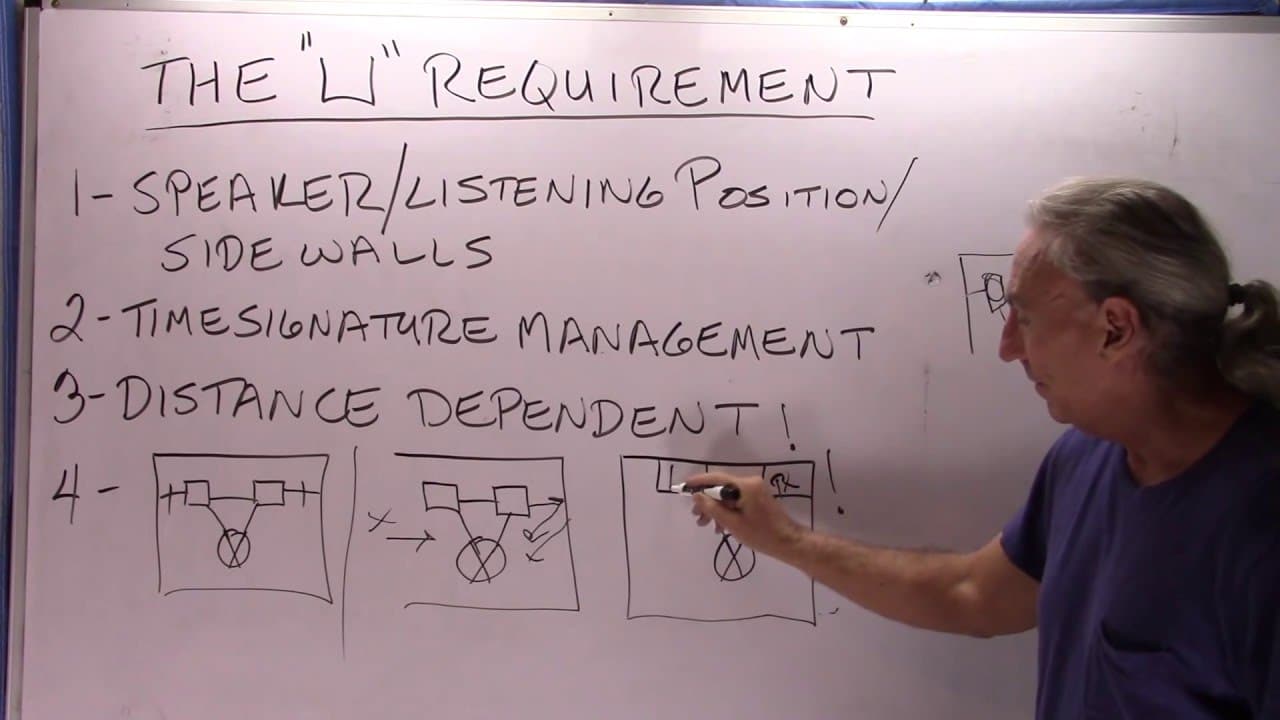Today we are going to talk about what I call the „U“ requirement. U meaning shape. And we will break that down for you and give you some idea. But the „U“ requirement is the speaker listening position in the side walls, it’s this relationship between the speakers and the side wall.
There is a time signature that we have to realize between our side walls and our speakers. Because what are we doing at the listening position, it’s a balance of direct energy from our speaker and obviously reflected energy from rooms surfaces. So side walls and things like that. We have to be very very careful, so that’s the U. So we want our speaker and our listening position to be surrounded by this inverted U. The back of the room can be open, there’s usually no issues with that. The minute I say that I’m going to get comments, „well, that’s not the case“. As a general rule, if we’ve got to have a open area in the room, I want it on the rear wall, not the front or the sides. The front and the sides have to be good. So it’s distance dependent because we are managing time signatures. Sound is an energy that moves at a specific rate and level of time, based upon the atmosphere it functions in, because it’s airborne. So our goal is to manage the reflections of these sidewalls, so that we get a balance of direct energy and reflected energy from the side walls. The goal is to set that up in a room that has both side walls and a front walls. A lot of times i see this setup, I see left in my channel setup, right side wall and no left side wall. Well, the time signature on this open area is going to be dependent on whats ever struck back here. We don’t know, so we don’t have any predictability, and we don’t have any consistency here with the right side wall and no left side wall. But both sidewalls have to be there, and the front wall also. So that’s where we get our U requirement.
Here is another situation I see a lot of times: have the right channel in a corner and left channel in about the mid room and the listening position skewed to one side. They have the triangle part right, the power triangle is right, but look at our reflections here. We’ve got the thing jammed in a corner, the right channel speaker. What we know from past, we’ve got speaker boundaries interference effect, which is probably a plus 3 dB gain, by putting it in the corner. You get more room sound, but I think we are all in an agreement now that more is not better, although there are a lot of companies that think that’s the case. More is ok, as long as it is defined and articulated. More for the sake of being more, quantity over quality is never welcome. Quality is always the goal.
So the bottom line here is, we need to manage these signatures from the sidewalls with the proper rating level of absorption. If we are choosing diffusion, the proper rating level of diffusion to match distances. It’s all married together no one rule fits all. In order to do that we have to have structures that allow that time signature to be consistent and predictable on the left and the right channel. If we don’t have a side wall on the left side and we have one on the right side, what do you think the time signature difference between the those reflection are going to be? Well, unknown. Because we don’t know what’s over here. So predictability, consistency, that’s why we like our rectangular rooms a lot, because there are four parallel surfaces, two groups of two, right? Actually three groups, floor and ceiling. So we get a predictable and consistent distance which allows you to have predictability and consistency in your time signature management. Always distance dependent and you must choose the proper rating level for the usage.
—
This is an unedited transcript from our video series from Acoustic Fields. There will be some errors in grammar and sentence structure that occur during this translation process.
For complete understanding and comprehension, please view the video which is included in this text. For any additional information regarding this topic or others relating to room acoustics, please contact us directly at:
P: 520 – 392 – 9486







